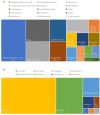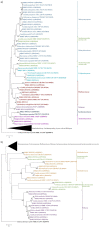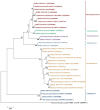Diversity of duckweed (Lemnaceae) associated yeasts and their plant growth promoting characteristics
- PMID: 37649804
- PMCID: PMC10462456
- DOI: 10.3934/microbiol.2023026
Diversity of duckweed (Lemnaceae) associated yeasts and their plant growth promoting characteristics
Abstract
The diversity of duckweed (Lemnaceae) associated yeasts was studied using a culture-dependent method. A total of 252 yeast strains were isolated from 53 duckweed samples out of the 72 samples collected from 16 provinces in Thailand. Yeast identification was conducted based on the D1/D2 region of the large subunit (LSU) rRNA gene sequence analysis. It revealed that 55.2% and 44.8% yeast species were Ascomycota and Basidiomycota duckweed associated yeasts, respectively. Among all, Papiliotrema laurentii, a basidiomycetous yeast, was found as the most prevalent species showing a relative of frequency and frequency of occurrence of 21.8% and 25%, respectively. In this study, high diversity index values were shown, indicated by the Shannon-Wiener index (H'), Shannon equitability index (EH) and Simpson diversity index (1-D) values of 3.48, 0.86 and 0.96, respectively. The present results revealed that the yeast community on duckweed had increased species diversity, with evenness among species. Principal coordinate analysis (PCoA) revealed no marked differences in yeast communities among duckweed genera. The species accumulation curve showed that the observed species richness was lower than expected. Investigation of the plant growth promoting traits of the isolated yeast on duckweed revealed that 178 yeast strains produced indole-3-acetic acid (IAA) at levels ranging from 0.08-688.93 mg/L. Moreover, siderophore production and phosphate solubilization were also studied. One hundred and seventy-three yeast strains produced siderophores and exhibited siderophores that showed 0.94-2.55 activity units (AU). One hundred six yeast strains showed phosphate solubilization activity, expressed as solubilization efficiency (SE) units, in the range of 0.32-2.13 SE. This work indicates that duckweed associated yeast is a potential microbial resource that can be used for plant growth promotion.
Keywords: diversity; duckweed; plant growth promotion; yeast.
© 2023 the Author(s), licensee AIMS Press.
Conflict of interest statement
Conflict of interest: All authors declare that there are no conflicts of interest in this paper.
Figures





Similar articles
-
Assessment of Diversity of Culturable Marine Yeasts Associated with Corals and Zoanthids in the Gulf of Thailand, South China Sea.Microorganisms. 2020 Mar 26;8(4):474. doi: 10.3390/microorganisms8040474. Microorganisms. 2020. PMID: 32225058 Free PMC article.
-
Yeast Diversity Associated with the Phylloplane of Corn Plants Cultivated in Thailand.Microorganisms. 2020 Jan 7;8(1):80. doi: 10.3390/microorganisms8010080. Microorganisms. 2020. PMID: 31936155 Free PMC article.
-
Evaluation of Multifarious Plant Growth Promoting Trials of Yeast Isolated from the Soil of Assam Tea (Camellia sinensis var. assamica) Plantations in Northern Thailand.Microorganisms. 2020 Aug 1;8(8):1168. doi: 10.3390/microorganisms8081168. Microorganisms. 2020. PMID: 32752164 Free PMC article.
-
Diversity of culturable yeasts in phylloplane of sugarcane in Thailand and their capability to produce indole-3-acetic acid.World J Microbiol Biotechnol. 2014 Jun;30(6):1785-96. doi: 10.1007/s11274-014-1602-7. Epub 2014 Jan 19. World J Microbiol Biotechnol. 2014. PMID: 24442819
-
Duckweed: Beyond an Efficient Plant Model System.Biomolecules. 2024 May 27;14(6):628. doi: 10.3390/biom14060628. Biomolecules. 2024. PMID: 38927032 Free PMC article. Review.
Cited by
-
Duckweed-associated bacteria as plant growth-promotor to enhance growth of Spirodela polyrhiza in wastewater effluent from a poultry farm.Arch Microbiol. 2023 Dec 26;206(1):43. doi: 10.1007/s00203-023-03778-4. Arch Microbiol. 2023. PMID: 38148332
-
Diversity and Antifungal Susceptibilities of Yeasts from Mangroves in Hong Kong, China-A One Health Aspect.J Fungi (Basel). 2024 Oct 20;10(10):728. doi: 10.3390/jof10100728. J Fungi (Basel). 2024. PMID: 39452680 Free PMC article.
References
-
- Landolt E, Kandeler R. Biosystematic investigations in the family of duckweeds (Lemnaceae), Vol. 4: the family of Lemnaceae-a monographic study, Vol. 2 (phytochemistry, physiology, application, bibliography) Veroeffentlichungen des Geobotanischen Instituts der ETH, Stiftung Ruebel (Switzerland) 1987 doi: 10.1007/BF00037640. - DOI
-
- Tippery NP, Les DH. Tiny plants with enormous potential: phylogeny and evolution of Duckweeds. In: Cao X.H., Fourounjian P., Wang W., editors. The Duckweed Genomes. Cham: Springer International Publishing; 2020. pp. 19–38. - DOI
-
- Sońta M, Rekiel A, Batorska M. Use of duckweed (Lemna L.) in sustainable livestock production and aquaculture–a review. Ann Anim Sci. 2019;19:257–271. doi: 10.2478/aoas-2018-0048. - DOI
LinkOut - more resources
Full Text Sources
